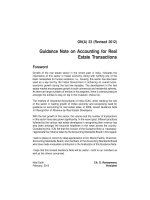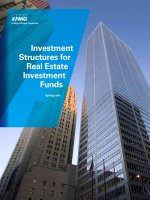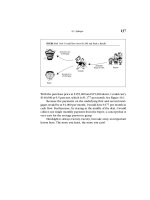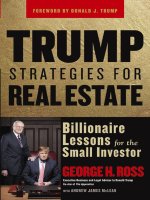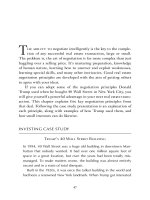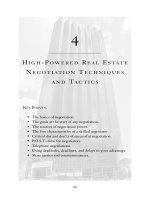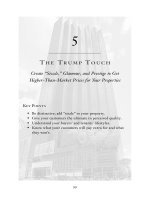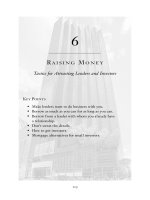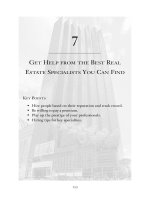TRUMP STRATEGIES FOR REAL ESTATE CHAPTER 5 pdf
Bạn đang xem bản rút gọn của tài liệu. Xem và tải ngay bản đầy đủ của tài liệu tại đây (1.3 MB, 25 trang )
99
5
T
HE
T
RUMP
T
OUCH
Create “Sizzle,” Glamour, and Prestige to Get
Higher-Than-Market Prices for Your Properties
K
EY
P
OINTS
•Be distinctive; add “sizzle” to your property.
•Give your customers the ultimate in perceived quality.
•Understand your buyers’ and tenants’ lifestyles.
•
Know what your customers will pay extra for and what
they won’t.
101
A
KEY PART OF
Tr u mp’ s re a l e state investing philosophy is his pas-
sion to ensure that whatever he is building or renovating is the
epitome of its type in terms of quality, prestige, beauty, workman-
ship, and meticulous detail. The creation of perfection is why, in
2003, nine out of the top ten highest selling condominium residences
in New York City were in buildings built by Trump. Trump proper-
ties consistently command a high premium over comparably located
and comparable sized properties because of the special exciting fea-
tures that embody what the industry recognizes as “the Trump
To uc h.” I f you want willing buyers to pay higher prices for your real
estate, you must include unusual, dazzling features that will appeal to
buyers or tenants on several emotional levels. Trump Tower on 5th
Avenue is a prime example of how this kind of “sizzle” can increase
thevalue of a property far beyond the cost of creating the sizzle. In
the following case study, you’ll learn techniques that Trump uses to
get the highest prices in the market for anything he sells or rents. I’ll
also show you how you can apply the same techniques, on a smaller
scale, to your own real estate investments.
INVESTING CASE STUDY
T
RUMP
T
OWER ON
5
TH
A
VENUE
Imagine yourself in midtown Manhattan walking down the most fash-
ionable part of 5th Avenue. When you get to 56th Street your breath
is taken away by a towering, modern, distinctive building with a
TRUMP STRATEGIES FOR REAL ESTATE
102
unique jagged facade of black glass. As you look up, your eye catches a
grove of 16 full-size trees planted on six floors of terraces the lowest of
which is 50 feet above the level of the sidewalk. Upon entering the 68-
story tower, you are flanked by attractive show windows of renowned
retail stores. You marvel at the highly polished floor of exquisitely
matched marble slabs which lead into the spacious high-ceiling tree-
lined lobby that ends at the huge seven-story atrium. Tumbling down
the far wall of the atrium is a 100-foot waterfall against a marble wall
that is topped by a large angled skylight that illuminates everything
below. The lower level of the atrium houses two fine eating places, one
of which is a tempting elaborate buffet and the other has starched
white tablecloths and elegant décor. Both facilities have excellent food
prepared by a master chef. Surrounding all of the furnishings, you no-
tice the perfectly matched marble-lined walls and the attention to de-
tail this interior space was given. Highly polished brass is everywhere.
Off to the left of the main entrance is a bank of elevators housed in
mir
ror-finish brass doors. As you approach the elevators, a well-
dressed security man asks you whom you are visiting. After receiving
the approval of the party you intend to visit, you are permitted to enter
the high-speed mirrored elevators to take you to your desired floor.
This is how people experience the lobby and office portion of
Tr ump Tower for t he f irs ttime.Itisdazzling,andproves Trumpisa
master at creating awe-inspiring buildings. The residential portion of
the building is a world unto itself. It has its own private entrance on
56th Street with 24-hour doorman and concierge service. The recep-
tion desk is staffed by uniformed personnel who are trained to recog-
nize all residents and screenallvisitors. Once visitors are cleared,
they are permitted to enter one of the immaculately clean elevators
where a uniformed operator inquires as to their destination and
whisks them to it.
Because magnificent views command higher prices, Trump de-
signed the building so that the residential portion of Trump Tower,
T
HE
T
RUMP
T
OUCH
103
Tr u mp Tower o n 5th Avenue
TRUMP STRATEGIES FOR REAL ESTATE
104
which contains luxury condominium units, would top the structure
starting at the 28th floor and rising to the penthouse on the 68th
floor. The views were enhanced by increasing ceiling heights, in-
stalling oversize windows, and using the jagged facade to create
multiple corners with windows facing different directions. By
adding a luxurious health club, fitness room, and other amenities,
Tr ump Tower achieved the highest prices per square foot ever re-
ceived for condominium units in New York City at the time it was
completed. Now that you have a sense of the finished product, let’s
look at how Trump conceived and executed this fabulous real estate
development, and how it paid off for him.
Before Trump Tower was built, the site was owned by the parent
company of Bonwit Teller, a fast-fading department store chain. The
building was an Art Deco box-like building that had long outlived its
usefulness but the location, on 5th Avenue in midtown Manhattan,
was one of the most prestigious in the entire city of New York. Al-
though the purchase price for the property was high, Trump be-
lieved that the location warranted it and a huge profit would be his
if he could maximize the site’s potential. Trump believed the ground
floor of a new building and the three floors above it could bring
very high rents (in excess of $500 per square foot) from major re-
tailers who coveted a 5th Avenue location for a flagship store. He
also believed that the high floors with their great views were ideal
for the creation of luxury condominium units that would sell for high
prices. The middle floors were the problem area that required inno-
vative thinking to obtain maximum benefit from their use and make
the investment work. Trump decided to use them as office space
knowing full well that it would take creative marketing to get the
rents he desired. Thus, Trump’s vision of a three-tiered, multi-use
condominium building was born. In the late 1970s, a development
of this type was very unusual.
T
HE
T
RUMP
T
OUCH
105
One ofthelessons for small investors to learn is to find ways,
when possible, to put your property to multiple uses, with multiple
income streams. If you can create a new use for the property that
didn’t previously exist, and a new income streamtogoalongwithit,
you will have dramatically increased the value of the property when
its time to sell or finance. For example, if you have a rental property
in thecity, you maybeable to charge extra for off-street parking, to
anyone who lives in the neighborhood. Or you may be able to offer
additional services to your tenants, such as Internet service or laun-
dryfacilities,for a fee. This strategy also helps to diversify the in-
come from the property so it doesn’t come completely from one
source (e.g., rents). This makes your income stream from the prop-
erty less risky, and therefore more valuable.
This multi-use strategy worked brilliantly in Trump Tower, but
there were several site-related issues that required resolution before
Tr u mp co u ld begin to build. One major problem was the fact that the
site consisted of utilizing more than one parcel of land. It included a
ground lease on a 25 foot by 100 foot parcel on 57th Street that was
owned by Leonard Kandell, an elderly, very savvy real estate developer
and investor. Knowing that the ultimate success of the venture hinged
on the size of the building he could build on the site, Trump tried to
buy Kandell’s property but Kandell refused to sell it at any price.
Tr ump’s only interest in buying Kandell’s parcel was because owner-
ship meant that he would have the right to build a larger building. I
enlightened Donald about the zoning laws that permitted one owner
to sell and transfer unused building rights (commonly called air rights)
from his property to the property of an adjacent owner. I told him, “If
somehow we can get Kandell’s air rights you don’t need to own his
piece of property.” Since Tiffany owned the adjoining property on the
corner of 5th Avenue and 57th Street which also had air rights, Trump
said, “Tiffany has air rights, too, so I’ll buy those.” He proceeded to
negotiate a deal with Tiffany to buy the air rights over their site.
TRUMP STRATEGIES FOR REAL ESTATE
106
During his meetings with Walter Hoving, the CEO of Tiffany,
Tr ump learned that Tiffany also had an option to buy Kandell’s site
for its fair market value. It was a nebulous option at best but Trump
felt it would be used as a wedge to get Kandell’s cooperation. Trump
made sure that the price he paid for Tiffany’s air rights also included
the option it held on the Kandell site. Then, armed with the Tiffany
option, Trump went to Kandell and said, “I’m going to exercise the
option to buy your site.” Kandell, who was not intimidated in the
least, countered with, “You’ll have to sue me to exercise the option
and I’ll fight you every step of the way. The delay would throw your
construction timetable into a cocked hat. W hen you finally win, we’ll
fight over what amount represents the fair market value of my site.”
This was shaping up as a classic battle between an unstoppable force
meeting an unmovable object. Trump respected Kandell’s willingness
to fight even though Kandell knew he would ultimately lose his site
despite the fact he would receive a high price for it. Trump knew that
Kandell had the reputation for being tough but a fair dealer. Sensing
the necessity of building a relationship based on mutual respect,
Tr ump called Kandell and asked, “Len, we don’t know each other but
it’s in both our interests to hammer out a deal that we can both live
with. What do you want?” Kandell replied, “Donald, although I
know you would pay me a lot of money for a deed, I’d like to continue
to own my 57th Street site and maybe we can agree on the terms of a
long-term ground lease that would include a fair rent which will pro-
vide income for my children and grandchildren and give you what
you need to build your building.”
Relying on his ability to create good business relationships,
Tr u mp asked me to join him and Leonard Kandell for lunch at the
University Club where Kandell was a member. Trump told Kandell,
“Even though I really want to buy your property, I’ll let you and
George try to work out a great lease that will provide substantial in-
come to your family and give me the flexibility I need.” Kandell
said, “Thanks, Donald, I appreciate your cooperation.” Before Don-
T
HE
T
RUMP
T
OUCH
107
ald left the meeting, he pulled me aside and said, “I’ve softened Len
up, but I really need the new lease ASAP; buying Kandell’s property
doesn’t make sense. Make the lease happen.” When I went back to
the table, Len Kandell said, “George, before we discuss the terms of
a new lease I want you to know I’m going to agree to a lease. If I
don’t, Donald will buy my site for a lot of money, but I’ll have a lot of
taxes to pay and I really can’t think of a better place to have money
invested than 57th Street and 5th Avenue. I leave it up to you to
draft a lease that meets Donald’s needs but is a fair deal for me.” I
was shocked by Kandell’s simple down-to-earth approach. He was
willing to place his trust in me even though he knew I was Trump’s
lawyer! He said to me, “I know you lawyers are all alike, it will take
you months to do a simple lease. At my age I don’t have months to
spare.” I said, “If your lawyer will cooperate I’ll have your lease done
in two weeks.” He said, “I’ll bet you can’t do it and I’ll give you 2 to
1 odds.” I accepted the challenge and he put up $2 against my $1.
Within two weeks, I prepared and finalized a long-term ground
lease with Kandell that gave Trump the air rights he needed and
gave Kandell a rental income commensurate with the value of the air
rights. One of Kandell’s two bucks is still on my wall today. The
other I gave to Trump for his cooperation in facilitating the lease
negotiations. The creation of the lease was the first step in a long-
term friendship between Donald Trump and Leonard Kandell that
proved invaluable in future dealings. The lesson for small investors
(to reiterate a point made in Chapter 1) is that you should never un-
derestimate the value of good relationships if you are going to be a
long-term real estate investor. Both Kandell and Trump were tough
negotiators, but they understood this.
Now that he had the air rights he needed to build a building tall
enough to justify the high cost of the location, Trump made some
very creative and profitable design changes that real estate investors
can learn from. He made a concession to New York City, by agree-
ing
to create a pedestrian walkway between 5th Avenue and Madison
TRUMP STRATEGIES FOR REAL ESTATE
108
Avenue, through the lobby of the commercial portion of Trump
Tower. For this concession, the city gave Trump a valuable bonus of
addi
tional square footage that he used to increase the number of
floors on the most profitable portion of the building, the luxury
apartments on the upper floors. But Trump went even farther to cre-
ate value by flanking the pedestrian walkway with retail stores and
showcases, which turned it into a moneymaker. The stores benefited
from the increased traffic using the walkway, and the wide walkway
with seating areas in the lower level made the public space in the
building atrium more attractive to shoppers.
Previously, New York City had passed a statute giving tax bene-
fits to developers who turned underutilized land into residential
units. These tax breaks were phased in over 10 years, and Trump was
able to pass them along to the buyers of the luxury condominium
apartments, which made it much easier to sell the units for the high
prices he sought. Small investors should be as savvy as Trump when
it comes to knowing about governmental incentives (and restric-
tions) on developing or renovating property. Sometimes taking ad-
vantage of tax breaks and other incentives can be the key to making
an investment profitable.
The concept of a mixed-use condominium building such as
Tr ump envisioned was not readily accepted by traditional mortgage
lenders, who are conservative by nature. Through his extensive con-
nections, Trump learned that Equitable Life Assurance Company
was interested in financing deals in which they also had a piece of the
ownership. I negotiated a joint venture agreement between Trump
and Equitable whereby Equitable agreed to put up all the money nec-
essary to build Trump Tower. In return, Equitable would eventually
receive all of its investment back, plus interest, from the sale of the
condominium units. Thereafter, Trump and Equitable would each
receive 50 percent of the profits.
But Equitable threw in a clinker that could have soured the deal.
Equitable had a policy that a lawyer or law firm that represented
T
HE
T
RUMP
T
OUCH
109
Tr ump or Equitable in creating the joint venture could not thereafter
represent the venture going forward. When I told Trump of this
wrinkle he said, “George, if you can’t be the lawyer for the venture,
I’ll kill the Equitable deal.” Although I sincerely appreciated his loy-
alty to me I replied, “Donald, with the Equitable deal you get back
your entire investment immediately, all the money you need for con-
struction, and 50% of the profits, it’s too good to pass up. I’ll still
be your lawyer on the deals yet to come.” When the joint venture
with Equitable was signed I thought I would no longer be involved
with Trump Tower. I was wrong.
After I was no longer Trump’s lawyer on Trump Tower, Leonard
Kandell called me and said, “George, I want you to be my lawyer and
handle all my legal matters.” I replied, “You’ll have to get Donald’s
okay.” He said, “I already did!” I then asked him, “You’ve got a good
lawyer already, why me?” He replied, “When you negotiated and
drafted the ground lease, I saw you in action. You’re not only a lawyer
but you know the real estate business. Whatever you charge, I’ll pay.”
That’s how I got Leonard Kandell as a client and even though he died
years ago, to this day I still represent his family in real estate matters.
So Trump Tower progressed as the multi-use building as Trump
had envisioned. The purpose of the design was to get maximum
value out of the three tiers of the structure by creating a condo-
minium with three different ownership levels. The retail stores on
the bottom six floors together with the public passageway created a
vertical mall, which helped draw people into the building and was a
good use of the space because the lower floors have limited views.
The commercial office space on floors 4 through 26 offered a presti-
gious 5th Avenue address along with the high-end services that come
with tenancy in a Trump building. This space also houses the Trump
Organization headquarters where Donald and I have offices. The
Tr ump-Equitable joint venture maintained ownership of all floors
below the 27th floor, and received the high, stable, rents that went
with them. The most desirable floors of the building (27 through 68)
TRUMP STRATEGIES FOR REAL ESTATE
110
were devoted to spacious luxury condominiums with incredible views
of Central Park and the Manhattan skyline.
Before commencing construction, Trump ran into another snag.
Before the building plans were submitted to the Department of Build-
ings with an application for a building permit, the architects told
Tr ump that the required width of the public walkway through Trump
Tower wou ld necessitate the placement of a corner beam straddling the
line of the site owned by Kandell. Trump called me as Kandell’s new
lawyer to get Kandell’s consent to an easement permitting the girder to
be installed in the requisite location. I spoke to Len Kandell and he
asked, “George, does it really diminish the value of my property?” I
replied, “No Len, it doesn’t, the area Donald needs is 38 feet below
street level and only covers a minor piece of your land.” Len said, “Tell
Donald I’ll give my consent gratis.” I gave Donald the go ahead. But
when the plans for the building were filed with the Department of
Building for approval, they came back and insisted that the public walk-
way be widened even more or it would not be acceptable for the air
rights, which would enable Trump to build the building to the height
he wanted. I got another call from Donald seeking Kandell’s consent to
the placement of a beam entirely on Kandell’s property. I told him that
this was an entirely different request but I would talk to Len Kandell
about it. When I told Len Kandell what Donald wanted, he again asked
me, “George, does this really diminish the value of my property?” I
replied, “Yes, it might, but not much.” Len thought a minute and said,
“I could probably get Donald to pay me $1 million or $1.5 million for
the rights he wants but he’s always been fair and square with me, so
give it to him for nothing.” I told Len that granting Trump the rights
he wanted might create a problem with the holder of the mortgage on
Kandell’s site and if there were a problem I thought Trump should, at
least, pay any difference in interest rates between the existing mort-
gage and any replacement mortgage. Kandell said, “Okay, get Donald
to agree to that.” When I called Trump, I was curious as to whether or
T
HE
T
RUMP
T
OUCH
111
not Kandell was right regarding how much Trump would be willing to
pay for the easement he wanted from Kandell. So I called him and teas-
ingly said, “Donald, Len will give you the easement you need but it’s
going to cost you.” Trump asked me, “How much?” I asked him,
“Would you pay one million for it?” Without hesitation he said, “Yes.”
I then said, “Would you pay two million for it?” Donald replied,
“That’s a high price for just an easement but if that’s what Kandell in-
sists upon, I’ll pay it.” I pushed further and asked, “If I can’t get Kan-
dell to do it for less than three million would you still do it?” At that
price, Trump exploded and said, “That’s outrageous and nothing but a
holdup. I’ll build Trump Tower without the easement.” I countered
with, “Donald, this is George, not some novice. The column you want
to put on Len’s property holds up the corner of the whole building.
Don’t tell me you don’t need it. Would you pay three million if I can’t
get Kandell to accept less?” After much grumbling, Donald reluctantly
agreed to the three million dollar price but said he was furious that
Kandell would hold him up for this amount. When I confessed that
Kandell had agreed to give it to him for nothing, he was ecstatic. He
asked me, “Why would Len do that?” I told him that Kandell felt Don-
ald had treated him fairly when he made a lease that was good for both
parties and he considered Donald to be a friend. Trump’s ability to
build relationships saved him $3 million.
As I mentioned, when Trump Tower was completed in 1983, the
concept of a mixed-use building like this was still relatively new.
Only the Olympic Tower which had been built in a comparable
area, 51st and 5th Avenue, was similar in concept. It was successful
but, of course, Trump went one better. He built a building that’s
unique from an architectural standpoint. By creating an irregular
saw-tooth facade, he ended up with rooms with light and views com-
ing from two directions, rather than having rooms with just one win-
dow exposure that are found in a typical building with a flat facade.
This feature also meant he could plant beautiful trees midway up the
TRUMP STRATEGIES FOR REAL ESTATE
112
structure’s facade. While Olympic Tower overlooked St. Patrick’s
Cathedral, Trump Tower overlooks the greenery of Central Park.
Consistent with Trump’s flair for showmanship, Trump’s signature in
this project was the distinctive seven-story cascading waterfall over
pink marble inside a spacious tree-lined atrium surrounded by exquis-
itely matched marble. (Trump reserved the entire Italian quarry just
so he could be assured that all the special marble used in Trump Tower
would match.) There could be no doubt that Trump had a great vision
for this building, but would it be successful as an investment? That de-
pended on finding extremely wealthy buyers to purchase the luxury
apartments. As it turned out, there was a backlog of people who
wanted something so exciting and exclusive.
A M
ARKETING
M
ASTERPIECE
—
U
NDERSTANDING
S
NOB
A
PPEAL
When he built Trump Tower, Donald created a market for ultra lux-
ury residential real estate in Manhattan that had not previously
existed. He had the foresight to believe that certain kinds of peo-
ple—celebrities, multimillionaires, chief executives of major corpo-
rations, and dignitaries from foreign countries, and others would pay
more for the convenience of a luxurious residence within walking
distance of their offices and the most prestigious shopping area in
central Manhattan. Trump Tower has the ideal and most valuable lo-
cation in the city, 57th Street and 5th Avenue. Using one of his fa-
vorite real estate investing strategies, Trump combined a prime
location with innovation.
He took a monumental entrepreneurial risk to execute his vi-
sion and to venture into uncharted waters where previously no one
had the courage to create a building that targeted this elite, undis-
covered market. Trump knew that there are people who willingly
pay $250,000 for a Rolls Royce (even though it’s still just a car) be-
T
HE
T
RUMP
T
OUCH
113
cause of the prestige and the aura associated with the celebrities
and the rich people who drive a Rolls. People like to communicate
the fact that they have money without specifically broadcasting it.
They accomplish this by driving a Rolls Royce, and also by living in
Tr ump Tower. If you own a Rolls Royce, people think you’re rich.
In the same way, ownership of a unit in Trump Tower equates with
being wealthy. People know that owners of apartments in Trump
Tower pay up to $20 million for the privilege—a price significantly
higher than similarly sized apartments in the neighborhood. They
recognize the value of buying ownership of a unit in a Trump build-
ing. With such ownership comes the privacy, exclusivity, and the
amenities found in a five-star building. As an added bonus, they get
what has come to be referred to as the “Trump Touch.”
In typical pioneering style, Trump embraced the challenge of
creating a product for a market that nobody else dared to enter.
Tr ump believed the market existed, and he was confident that the
wealthy would flock to his spectacular building. He even pro-
claimed, “I will sell residential units at higher prices than anyone
else. I will sell units at $1,000 per square foot while owners of similar
units elsewhere struggle to get $600 per square foot.” Some said that
Tr u mp was crazy and his outlandish predictions would never become
reality. Trump ended up selling units for $1,000, $1,200, sometimes
$1,500 a square foot. The same unit without the Trump name
wouldn’t sell anywhere near that price; it just wouldn’t exhibit the
same pizzazz. It wouldn’t have snob appeal.
The combination of a desirable location for retail space, offices,
and luxury apartments in the same building made Trump Tower a
fi
nancial success because it maximized the value of each level of the
building. Normally, a mix of commercial, office, and residential isn’t
financially feasible. But by combining a great location with incredi-
ble views and stunning architecture, Trump firmly believed he could
get higher rents and selling prices per square foot in Trump Tower
than anyone else was getting in the city. And he did!
TRUMP STRATEGIES FOR REAL ESTATE
114
F
OUR
T
ECHNIQUES
T
HAT
D
AZZLE
R
EAL
E
STATE
B
UYERS AND
T
ENANTS
Now let’s explore the special elements that added sizzle, glamour,
and prestige to Trump Tower. You will also see examples of how
small investors can use these same basic techniques to get higher-
than-market prices for any kind of property.
B
E
D
ISTINCTIVE
; A
DD
“S
IZZLE
”
TO
Y
OUR
P
ROPERTY
Tr ump’s trademark is to install an expensive, showy, unique feature
in every property, one which will be seen by everyone who enters. An
example is the $7 million, 120-foot waterfall at Trump’s Westchester
golf course. It is seen by everyone who plays there and creates a visual
landmark. Golfers stop and admire it, talk about it, and before you
know it, even nongolfers vie for the opportunity to play the course
just to see it. It’s the signature hole that’s truly a conversation piece,
andit’sone of thereasons people will pay $250,000 to become a
member at Trump International Golf Course.
Ask yourself: What kind of signature design element could you
add to your property that can be seen from the entrance, that would
dazzle and impress your buyers or tenants? The core elements in
Tr ump Tower that helped create “sizzle” and sky-high values are:
1.
The Architecture. Jagged saw-tooth curtain wall on the exterior of
the structure that created more views and visual interest than
a typical box-type building. Due to this special feature, the
view was in two directions from all locations, instead of a one-
directional view inherent in ordinary buildings with a flat facade.
2.
Interior Design. An illuminated seven-story waterfall cascading
over finely matched Italian marble in a spacious, thoughtfully
designed atrium. Tourists come from all over the world to
T
HE
T
RUMP
T
OUCH
115
pho
tograph this attraction, Trump’s signature touch in this de-
velopment. It was very costly, but everyone who enters the
building hears and sees it. It has paid for itself many times over.
3.
Landscaping. The grove of trees strategically planted along five
floors of the facade, at the corner of 56th Street and 5th Avenue.
4. Location overlooking Central Park, in the heart of the most
important and wealthy business district in America—Mid-
town Manhattan.
Yo u’ve seen how Donald Trump does it but you might ask, “How
can I, on a much smaller scale, go about adding sizzle and prestige to
maximize the value of my property?” The real secret for property of
any size is creating something visually striking. It’s perceived value.
It doesn’t have to be expensive, but it has to be perceived as valuable.
This can be accomplished by a stylish choice of colors, by the type of
impressive plantings or desirable amenities so that the potential cus-
tomer thinks, “This looks like a really nice place to live.” It all comes
together to create the image of desirability.
What makes something appear desirable? It could be the polished
brass hardware or the molding on doors, or the type of wood that the
door is made from. It could be window treatments or the immediate
availability of maintenance when required. These enhancements are
not necessarily expensive. It’s the intelligent way of blending creative
things together to create the aura of perceived value.
Landscape Design for Visual Impact
Landscaping the exterior should never be overlooked. Even small in-
vestors should hire a competent landscape designer. Many are reason-
ably priced. There is a perceptible harmony to what they do.
Designers can create a landscape that reinforces the impression of de-
sirability, without the necessity of costly maintenance. They also have
the ability to choose plantings that enhance the topography, the
TRUMP STRATEGIES FOR REAL ESTATE
116
structures, or maximize the size of the site. Instead of arbitrarily
putting in three or four bushes, consider planting bushes or shrubs
that are carefully chosen to look appropriate in the area and that can be
easily maintained and won’t become overgrown too quickly. Maybe a
small piece of tasteful sculpture or a small fountain could make a prob-
lem area a little more attractive while diverting attention away from
something negative. Often a piece of sculpture, complemented by care-
ful placement of well-conceived shrubbery, can turn a ho-hum garden
area into a showplace. A curved stone or brick walkway bordered with
attractive plantings is another desirable feature for any property.
Tr u mp t a k es landscaping very seriously. At Trump International
Golf Course in Florida, Donald had 2,000 trees transplanted—and
theseweren’tlittle trees, they were big—which made a spectacular
impact and beautified the property. This was in addition to hundreds
of bushes and shrubs planted on or around the golf course. In all, over
1.3 million cubic yards of earth was utilized to develop the facility.
(That’sthe equivalent of approximately 144,500 cement trucks full of
dirt.) Trump raised the height of the 18th tee to 80 feet, making it the
highest elevation in Palm Beach County. He transformed the site into
aspectaculargolfcourse.ThisishowTrumpdoesit.Hemakesallof
hisprojects exclusive and different from what others choose to create.
You don’t have to plant 2,000 trees on your property, but you can
find a way to make your landscaping distinctive. Landscape designers
come in all sizes. Get someone who is up and coming, and who really
wants to make it big. If you hire people who are good, you use them
on future properties. To induce them you might say, “Look, this is
the first four-unit building I have purchased, but I intend to buy six
more and I would like to use your expertise for all of them.” If you
can get your landscape designer excited about future work he or she
will be motivated to do an exceptional job.
Once a potential occupant perceives the exterior of your building
to be a nice place to live or work, the inside must visually seal the sale.
T
HE
T
RUMP
T
OUCH
117
G
IVE
Y
OUR
C
USTOMERS THE
U
LTIMATE IN
P
ERCEIVED
Q
UALITY
The key principle here is “spend money where it can be seen.” For ex-
ample, Trump pays more for chairs in lobbies and atriums than those in
interior rooms. He would, for example, easily pay $15,000 for a piece of
furniture in the clubhouse of Mar-a-Lago, his Palm Beach country
club, because it’s in a strategic location where people are going to see it.
Tr u mp t r ies to use whatever works to attract a person looking for lux-
ury, but his credo is “spend money where it can be seen.”
Small real estate investors need to ask themselves, “What can I
do with this property that no one else is doing—to make it distinc-
tive?” The answer is to try to get away from the commonplace and
give tenants and buyers more than they might expect. You can often
do this by adding small, but impressive upgrades to your property.
This requires vision and creativity, and an intuitive sense for what
will impress people. If you don’t have this aesthetic sense yourself,
you can hire an architect or designer who does, provided he or she
knows how to work within your budget. Trump found a way to sell
apartments at unheard of prices: $1,000 or more per square foot when
everyone else was struggling to get $600. Ask yourself, what design
elements could I build or renovate into my property that would make
it more desirable than any competing property of its type in its neigh-
borhood? With some concentrated effort, you can find the answer.
Be willing to overpay on a few critical details of your building or
renovation project; the aesthetics must be dramatic and draw people
in and impress them. You can use large entry rooms to make a state-
ment. Spaciousness is always distinctive. For example, the upper level
residential units in Trump Tower have much higher than typical
ceilings, which make the units appear more spacious, which in turn
gives the units a greater perceived value. Try to incorporate higher
ceilings in your plans if your budget permits.
T
HE
T
RUMP
T
OUCH
119
When it comes to bathrooms, try to make them as spacious as
circumstances allow. Put extra dollars in countertops, vanities, and
lighting fixtures. The bathtub should be a Jacuzzi, if feasible. Stor-
age space and soothing color combinations are necessities.
Another winning feature is closets with built-ins such as shoe
racksand adjustable shelving. Always ask yourself, “Where can I
spend my renovation or building money to make the greatest visual
impact?” Put your money on the answer.
Lawrence Welk and the $50/Yard Carpeting
Here’s a great example of a real estate investor who added “the Trump
Touc h” t o h i s property, with great results. I have a friend in Los Ange-
les who in the late 1970s was married to the resident manager for one
of Lawrence Welk’s buildings. (In case you’re too young to remember,
Lawrence Welk had his own hit television show which ran for 17 years
during the 1970s and 1980s.) With the huge profits from the show,
We lk invested heavily in southern California real estate, including
Champagne Towers, a very exclusive high-rise apartment building that
overlooked the Santa Monica Pier and the Pacific Ocean. This friend
purchased a 20-unit fixer-upper in a rough part of south central Los
Angeles. Meanwhile, his wife Peggy, the manager of Champagne Tow-
ers, was responsible for replacing the carpet every time a tenant moved
out of Champagne Towers, with new carpet of the tenant’s choice. The
carpeting being replaced was very expensive, top-of-the-line stuff that
cost $50/yard and in many cases was hardly used. So my friend bought
it from his wife (at the market price for used carpet of $1/square yard)
and began installing it in the 20-unit building he owned. Now imagine
this thick, plush “Berber-like” carpeting being installed in ghetto-like
apartments in a very rough neighborhood. The buzz among the build-
ing’s residents was unbelievable. The resident manager had to create a
waiting list for people in the neighborhood who had heard about the
TRUMP STRATEGIES FOR REAL ESTATE
120
carpeting and wanted to live there. My friend was able to receive
higher rents, and the building seldom had vacancies, all because of
this fancy carpet. It had the same effect as if the whole building had
been renovated, but for a fraction of the cost. The moral is, look for
cost-effective
ways to impress your buyers and tenants. You may pay a
little more than your competition, but if it enables you to charge more
rent or get a higher selling price, it’s worth it.
A Word of Caution: Never lose your focus on the bottom line of your
investment. It is possible to lose control and spend too much on up-
grades, even though the reality is that most real estate investors proba-
bly don’t spend enough. It is important to create a spreadsheet listing all
anticipated costs associated with your property’s acquisition, possible
holding periods, construction, and marketing. After considering all the
expense items, give careful thought to the anticipated income. Strike a
balance between unbridled enthusiasm and realism in your financial
projections. If the result meets your expectations, go for it!
U
NDERSTAND
Y
OUR
B
UYERS
’
AND
T
ENANTS
’ L
IFESTYLE
Before proceeding with any real estate venture, you have to determine
what’s appropriate for your particular project. You must familiarize
yourself with the surrounding neighborhood and the life style and in-
come of the people you are planning to sell or rent to. To accomplish
this, you have to do your homework, which includes doing research
and learning as much as you can about your potential customers. Can-
vass other projects in the area; speak to brokers whose livelihood
comes from the sales or leasing of units. If you portray yourself as a
potential buyer or renter, brokers will deluge you with loads of infor-
mation that you can distill to reality. Find out what amenities are
being offered by other developers building properties similar to yours.
T
HE
T
RUMP
T
OUCH
121
When he designed Trump Tower with luxury condominiums,
Tr ump recognized the fact that there are well-paid major executives
in all the big corporations, and that many movie stars and celebrities
would wantaprestigious building in a prime location—and would
payapremium price. Many owners travel extensively and use their
units as a home away from home while they’re in New York City. Ex-
ecutives of big corporations, especially foreign executives from Eu-
rope or Asia, want a place in a convenient location where they can
entertain guests in plush surroundings and be comfortable. Trump
Tower ’ s location, at 56th Street and 5thAvenue,whichisinwalking
distance of all the major buildings in Manhattan, was ideal. They
could buy aresidential unit in the corporate name and use it as their
headquarters while they’re in the city.
Tr u mp Tower offers residents numerous amenities such as a
beautiful spa and fitness facility, concierge service, separate attended
elevators, 24-hour doorman, whose duties include hailing taxicabs,
accepting packages, and calling you when your limousine arrives.
Small investors can do the same thing on a different scale by offering
buyers or tenants special amenities that will impress them and sell
them on your site.
Use Feng Shui to Boost Property Values
Here’s a case in point which demonstrates the importance of under-
standing your customers’ lifestyle. This example is Trump Interna
tional
Tower on Columbus Circle in New York City. During the planning
stages, Trump knew Asians were a likely source of potential buyers,
and that the building he was constructing should cater to their de-
sires
. So he had feng shui experts advise him on the design of the
building. Feng shui is an ancient Chinese philosophy involving the
relationship of individuals with their surroundings
. It’s a standard
of practice for creating the ideal environment in which to live and
TRUMP STRATEGIES FOR REAL ESTATE
122
Tr ump International Hotel and Tower
T
HE
T
RUMP
T
OUCH
123
work. Essentially, it’s a philosophy that distinguishes good signs
from bad signs, and teaches methods of design that are in harmony
with nature and the surrounding area. The Asian populace embraces
it. They will not buy into any building if the principles of feng shui
have been violated. The feng shui experts’ analysis of this site told
Tr ump that certain aspects of the building did not comply with the
laws of feng shui. Relying on their opinion, Trump redesigned the lo-
cation of the building entrance so that it would be in harmony with
the surrounding area. Trump even had the building blessed in a spe-
cial ceremony conducted by feng shui experts and, of course, he made
sure there was a lot of publicity about it which found its way into the
Asian media. The fact that Trump showed his concern for Asian
cul
ture, and spent a lot of money and time to do it, attracted Asian
people to the building. The owner’s sensitivity to their special re-
quirements was a major inducement.
K
NOW
W
HAT
Y
OUR
C
USTOMERS
W
ILL
P
AY
E
XTRA
FOR AND
W
HAT
T
HEY
W
ON
’
T
The probability of attention-getting “extras” paying off strictly de-
pends on the location and type of real estate project you are invest-
ing in. For example, if you’re refurbishing a four-unit residential
building, you should canvass other comparable buildings in the area
to find out what they offer as “building standard” and what typical
rental rates have been achieved. For this type of project, the items to
be considered in building standard would be carpeting; painting;
kitchen appliances and cabinets; air conditioning units; television
access by means of an antenna, cable, or satellite; and lighting fix-
tures to name a few. Unless you’re certain that your tenants would
pay a higher rental for a building standard that includes items that
would normally be “extras,” I suggest that you offer the tenant
TRUMP STRATEGIES FOR REAL ESTATE
op
tional upgrades that you would be willing to supply for a higher
rental rate. For example, the building standard refrigerator could
have a 17.5 cu. ft. capacity but an option could be one of higher ca-
pacity. Standard kitchen countertops could consist of Formica or
similar laminates. Options could include granite, ceramic tile, or
solid surface materials such as Corian or Stilestone, the extra cost of
which is included in the rent.
In any real estate deal, it’s important for you to identify your tar-
get audience and focus your attention on accommodating it. If your
target is middle-class families and you elect to provide amenities
typically found in developments catering to those with higher in-
comes, you won’t recoup the extra expense. However it is a fact that
most people, no matter their income level, will pay a little more for
luxury. Although you may be targeting middle-income buyers, you
should identify the cost-effective upgrades that will dazzle them and
make them willing to pay a little more than they otherwise would.
People who can afford luxury will recognize more extravagant extra
touches such as heightened security, 24-hour doormen, and closed-
circuit cameras or gated and manned entry areas. These are things
they can appreciate as having added value. Unfortunately, the lines
between low-income families, middle-income families, and high-
in
come families are blurry at best and difficult to pin down. After
you’ve obtained all the knowledge of your likely buyers or tenants as
you can, then go after that target. Having said that, be willing to
quickly revise your ideas about what your customers want, if you
learn new facts that warrant such a change. Success in any real estate
venture has a direct relationship to appropriate timing and the
changes in circumstances that occur in any timeframe. Be aware of
everything that’s happening in the local economic and real estate cli-
mate that could affect your decision making. Smart real estate in-
vestors, just like entrepreneurs in general, have to stay flexible.
124

